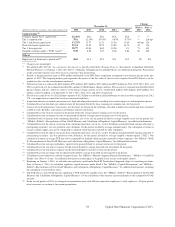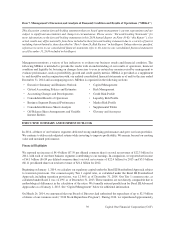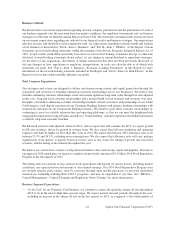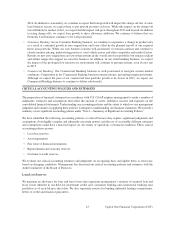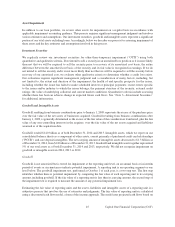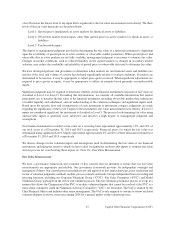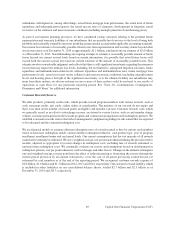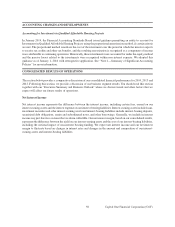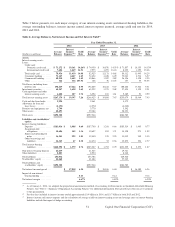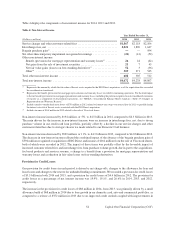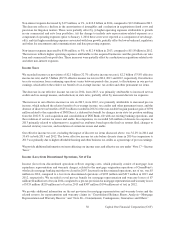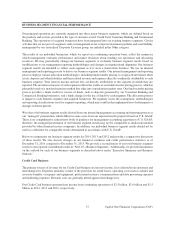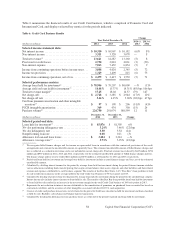Capital One 2014 Annual Report Download - page 70
Download and view the complete annual report
Please find page 70 of the 2014 Capital One annual report below. You can navigate through the pages in the report by either clicking on the pages listed below, or by using the keyword search tool below to find specific information within the annual report.The CVG performs periodic verification of fair value measurements to determine if assigned fair values are
reasonable. For example, in cases where we rely on third party pricing services to obtain fair value measures, we
analyze pricing variances among different pricing sources and validate the final price used by comparing the
information to additional sources, including dealer pricing indications in transaction results and other internal
sources, where necessary. Additional validation procedures performed by the CVG include reviewing (either
directly or indirectly through the reasonableness of assigned fair values) valuation inputs and assumptions, and
monitoring acceptable variances between recommended prices and validation prices. The CVG and the Trade
Analytics and Valuation team (“TAV”) perform due diligence reviews of the third party pricing services by
comparing their prices with prices from other sources and reviewing other control documentation. Additionally,
when necessary, the CVG and TAV challenge prices from third-party vendors to ensure reasonableness of prices
through a pricing challenge process. This may include a request for a transparency of the assumptions used by the
third party.
The FVC, which includes representation from business areas, our Risk Management division and our Finance division,
is a forum for discussing fair market valuations, inputs, assumptions, methodologies, variance thresholds, valuation
control environment and material risks or concerns related to fair market valuations. Additionally, the FVC is
empowered to resolve valuation disputes between the primary valuation providers and the CVG. It provides guidance
and oversight to ensure an appropriate valuation control environment. The FVC regularly reviews and approves our
valuation methodologies to ensure that our methodologies and practices are consistent with industry standards and
adhere to regulatory and accounting guidance. The Chief Financial Officer determines when material issues or
concerns regarding valuations shall be raised to the Audit Committee or other delegated committee of the Board of
Directors.
We have a model policy, established by an independent Model Risk Office, which governs the validation of models
and related supporting documentation to ensure the appropriate use of models for pricing. The Model Validation
Group is part of the Model Risk Office and validates all models and provides ongoing monitoring of their
performance, including the validation and monitoring of the performance of all valuation models.
Representation and Warranty Reserve
In connection with their sales of mortgage loans, certain subsidiaries entered into agreements containing varying
representations and warranties about, among other things, the ownership of the loan, the validity of the lien securing
the loan, the loan’s compliance with any applicable loan criteria established by the purchaser, including underwriting
guidelines and the ongoing existence of mortgage insurance, and the loan’s compliance with applicable federal,
state and local laws. We may be required to repurchase the mortgage loan, indemnify the investor or insurer, or
reimburse the investor for loan and lease losses incurred on the loan in the event of a material breach of contractual
representations or warranties.
We have established representation and warranty reserves for losses that we consider to be both probable and
reasonably estimable associated with the mortgage loans sold by each subsidiary, including both litigation and
non-litigation liabilities. The reserve-setting process relies heavily on estimates, which are inherently uncertain,
and requires the application of judgment. In establishing the representation and warranty reserves, we rely on
historical data and consider a variety of factors, depending on the category of purchaser. These factors include, but
are not limited to, the historical relationship between loan losses and repurchase outcomes; the percentage of
current and future loan defaults that we anticipate will result in repurchase requests over the lifetime of the loans;
the percentage of those repurchase requests that we anticipate will result in actual repurchases; and estimated
collateral valuations. We evaluate these factors and update our loss forecast models on a quarterly basis to estimate
our lifetime liability.
Our aggregate representation and warranty mortgage reserve, which we report as a component of other liabilities on
our consolidated balance sheets, totaled $731 million and $1.2 billion as of December 31, 2014 and December 31,
2013, respectively. The adequacy of the reserve and the ultimate amount of losses incurred by us or one of our
48 Capital One Financial Corporation (COF)


